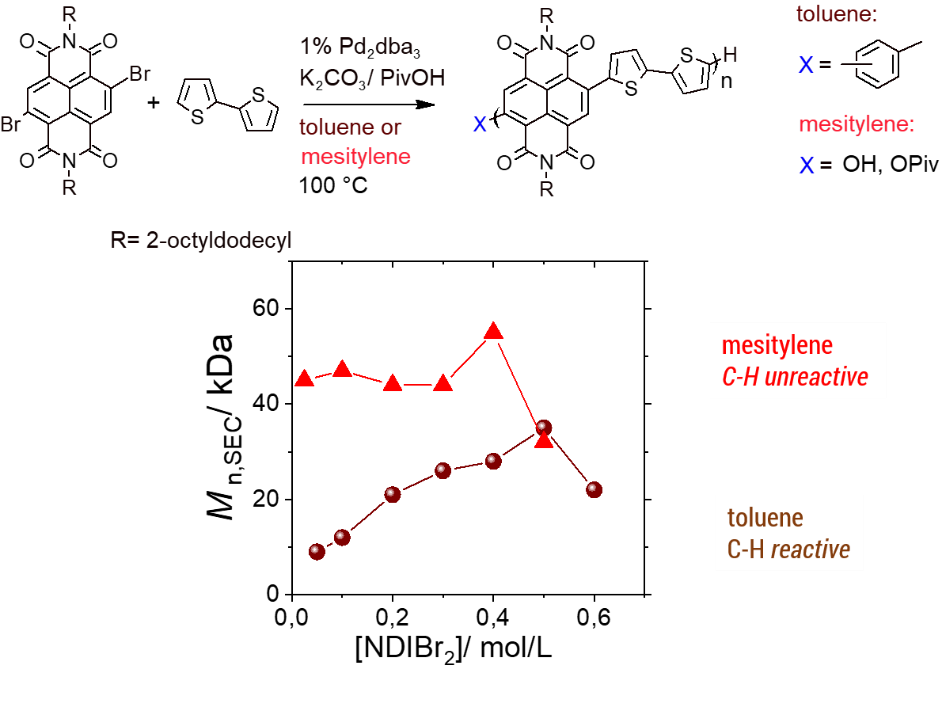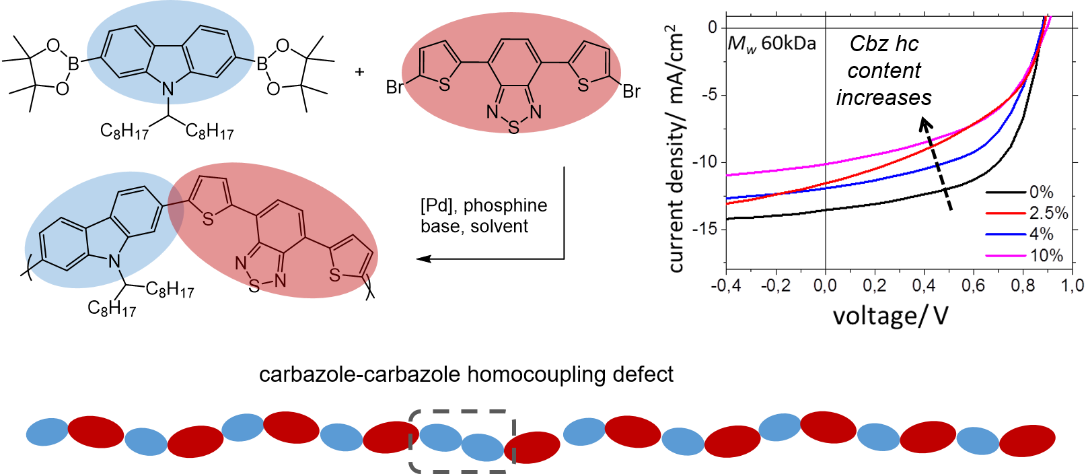Conjugated materials for organic electronics
Our contribution to the development of more sustainable materials We use C-H activation chemistry as an atom-economic cross-coupling variant to build up conjugated backbones. A major aspect includes usage of rather simple building blocks as well as the optimization of protocols to render them suitable for polycondensation reactions. In many cases direct arylation polycondensation (DAP) is at least competitive with traditionally used cross-coupling schemes based on Stille or Suzuki chemistry.[1–4] Under certain circumstances, additional benefits arise from controlled in-situ end capping through solvent C-H activation, which enables reproducible molecular weight control.[5]
Defect-property relationships
A further focus is on the analysis of molecular defects that form unintentionally during polymerization. Such defects can be of different nature, including branching[6], incorporation of phosphines, end groups[3] and homocouplings.[7,8] The latter type of defect occurs most often and can be identified using NMR spectroscopy.[8,9] In collaboration with other groups, we also investigate for which applications and type of device defects are problematic or not[9–11], due to performance degradation and reproducibility.Electron acceptor materials for organic thermoelectric generators
Our group explores concepts, materials and synthetic techniques to synthesize materials for organic thermoelectric materials. We mostly look at acceptor structures with low-lying LUMO energy level and aim to merge aspects of synthetic simplicity, sustainability, dopant miscibility, air stability in the doped state, processability and tunable conductivity. Examples include naphthalene diimide bithiophene copolymers of type PNDIT2 with backbone modification[12], oxygen-sulphur exchange[13,14], and side chain modification.[15] Thermoelectric characterization is performed in close collaboration with a number of research groups.
Materials for organic solar cells
We investigate conjugated materials for organic solar cells by looking at new acceptors and donors for fullerene-free solar cells. Anything that allows to increase sustainability, simplicity, morphology control or to understand the role of a certain defect type on device performance lies within our interest. The example here shows a carbazole homocoupling defect embedded in PCDTBT which influences solar cell performance negatively. [9,10]
References
[1] F. Lombeck et al., Macromol. Rapid Commun. - 2015.
[2] R. Matsidik et al., J. Am. Chem. Soc. - 2015.
[3] R. Matsidik et al., J. Mater. Chem. C - 2016.
[4] R. Matsidik et al., Eur. J. Org. Chem - 2018.
[5] R. Matsidik et al., ACS Macro Lett. - 2015.
[6] F. Lombeck et al., Polym. Chem. - 2017.
[7] F. Lombeck et al., ACS Macro Lett. - 2014.
[8] S. Broll et al., Macromolecules - 2015.
[9] F. Lombeck et al., Adv. Energy Mater. - 2016.
[10] M. Streiter et al., Adv. Funct. Mater. - 2019.
[11] Q. Wang et al., Chem. Mater. - 2021.
[12] Y. Shin et al., Adv. Electron. Mater. - 2018.
[13] Y. Shin et al., Macromolecules - 2018.
[14] D. Nava et al., ACS Appl. Energy Mater. - 2018.
[15] Y. Shin et al., Macromolecules - 2020.
